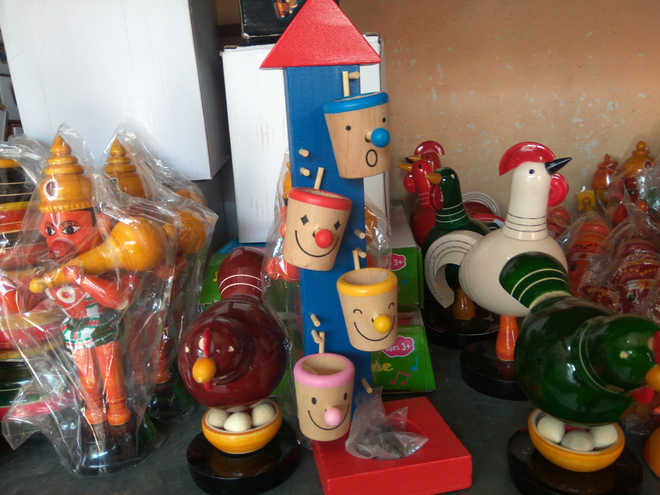
Handmade craft: The process of making these toys is manual and labour-intensive Photos by the writer
Rashmi Gopal Rao
Defence Minister Nirmala Sitharaman recently tweeted a photograph of the one-and-a-half-year old prince Gyalsey of Bhutan playing with Channapatna toys. The wooden toys from Channapatna were also in news when these were showcased at the London Design Fair this year.
“Welcome to the Land of Toys” says the green signboard as you drive down to Channapatna on the Mysore-Bengaluru highway. Located about 60 km from Bengaluru, the town is also known as “Gombegala Ooru” in Kannada, which translates into toy town. The little town is synonymous with the production of wooden toys and lacware, which is a traditional craft protected as a geographical indication (GI) under the World Trade Organisation. Administered by the state government, the toys have gained immense popularity over the years and are showcased regularly in the Republic Day parade representing the heritage of Karnataka. These toys were bought by the then US First Lady Michelle Obama during her visit to India in 2010 and were also gifted to the US President Barack Obama when he visited the country in January 2015.
The toys date back to the time of Tipu Sultan, who had a stronghold over the Mysore region towards the end of the 18th century (1782-1799). He was a great fan of wooden toys and brought artisans from Persia to train the locals in the manufacture of these toys. Traditionally done using ivory wood, rosewood and sandalwood, the craft has evolved over time. Now materials like rubber, cedar, pine and teak are also used. While artisans still rely on traditional methods of manufacturing, new designs, colours and patterns are being adopted to increase the appeal and reorient this craft to suit the present-day context. Nearly 50 factories and about 260 homes are involved in the manufacture of these toys.
The major raw material for the toys is the wood of the Wrightia tinctoria tree that is colloquially known as Aale mara (ivory wood) that is found in abundance locally. The wood that grows here is light and has grains that are densely packed, making it amenable to the manufacture of the toys. Once the wood is procured, it is seasoned for a couple of months and then cut into square, circular or cylindrical pieces based on the design using a lathe machine. The pieces are smoothened using a sand paper after which the lacquer is applied. The latter is done on the lathe machine itself so that the lacquer bonds well with the wood while is still hot due to friction. After uniform applications, the pieces are removed and assembled together based on the design. Vegetable and natural dyes are used to apply colours that are typically bright like indigo, red, yellow, orange, green, etc. Final touches are given in the form of decoration and painting. A wide variety of toys and lifestyle items like boxes, key rings, pen stands, candle holders, traditional dolls and jewellery are produced in myriad hues and designs. Apart from adorning homes, these form great gifting ideas.
The process of making these toys is largely manual and labour-intensive. Moreover, the lack of demand and a viable market for toys had this industry on the brink of closure at the turn of the century. With no financial and marketing support, the toy industry faced a major crisis. But with the timely intervention of the state government via the Karnataka Handicrafts Development Corporation (KHDC), things have improved. A Lacquerware Craft Complex, which is a manufacturing centre with 32 turning lathe machines, was set up at Channapatna. Financial assistance and training is imparted to the locals to keep them updated about the latest trends and designs.
However, many of the next generation are reluctant to continue the craft. Many companies and social organisations are trying to revive this craft and preserve the legacy of these toys that are not only indigenous but also safe, non-toxic and more importantly of immense heritage value.



























